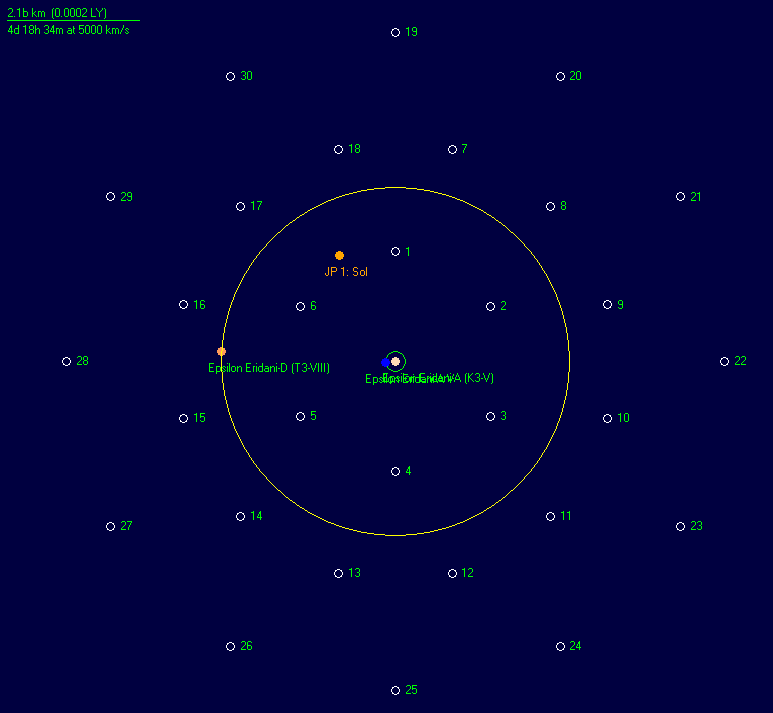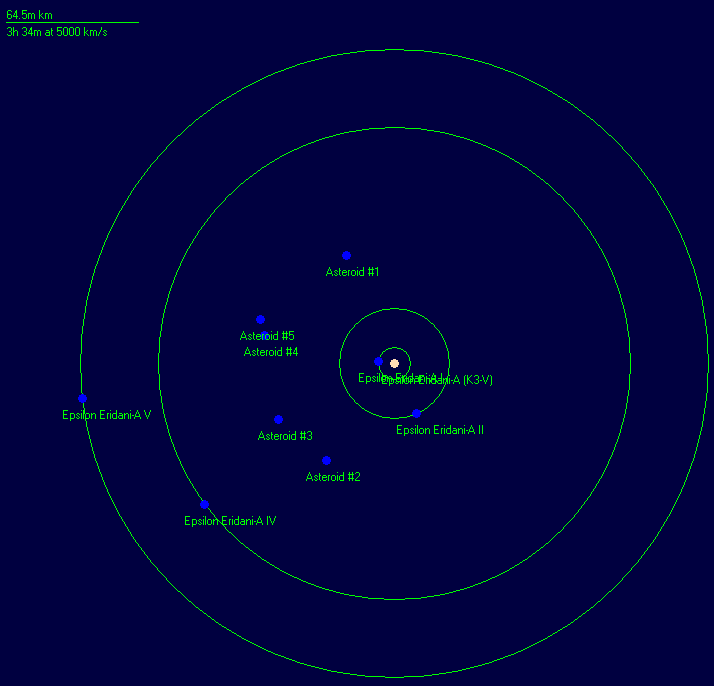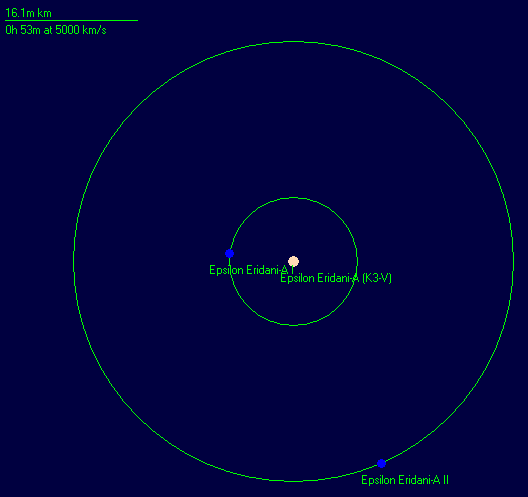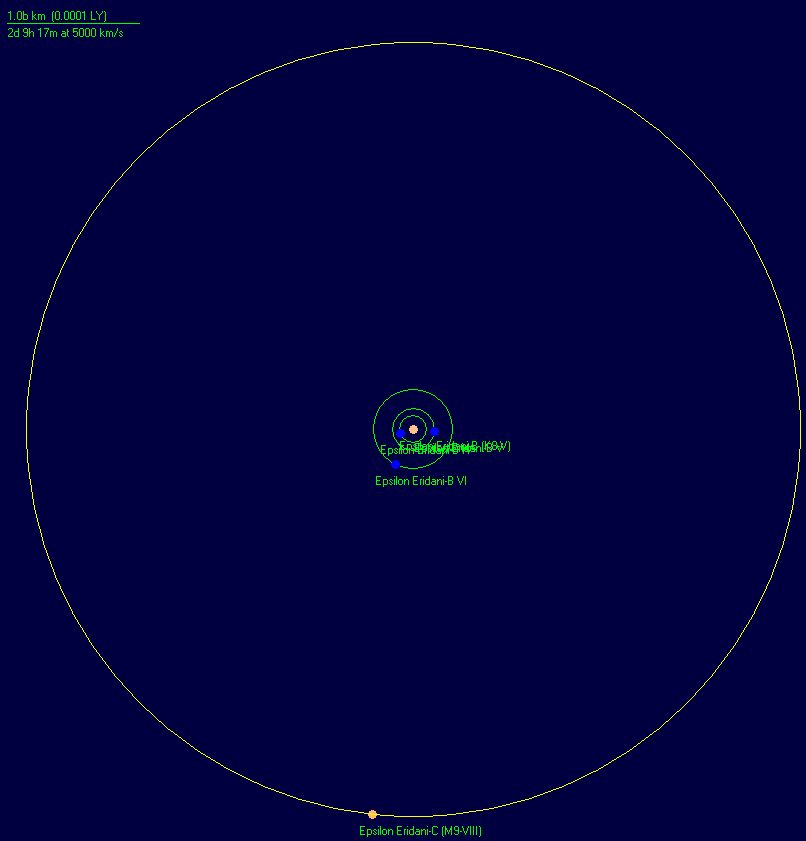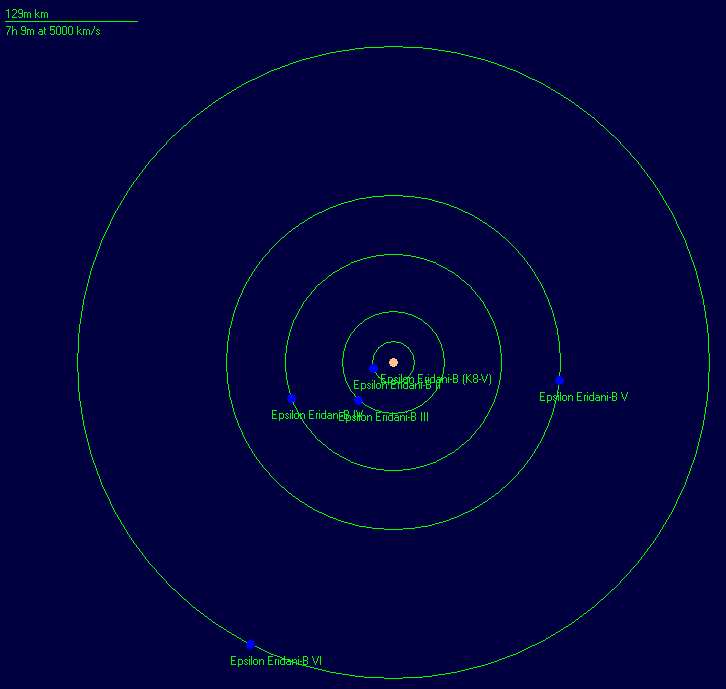Klondike-Kagayan
Link to Systembodies Raw Viwer
Right Ascension: 16h 22m 47.99s
Declination: -45° 27' 0"
Distance: 192.23 parsecs (627 light years)
Klondike-Kagayan, informally K2, K-K or JP1, is a UN-claimed binary star system accessed from Sol by an ungated wormhole near the orbit of Jupiter.
K2 is a huge system, several billion kms across and contains few habitable planets around the distant secondary star. K2 is occupied by hostile aliens, which destroyed the exploratory vessels Klondike and Kagayan for whom the system is named.
A communication effort was launched to try to establish a dialogue with the aliens to no avail. The program was discontinued in November 2035, as the aliens were either non-communicative or ignoring us.
Klondike-Kagayan was the first star system to be mentioned in the Belnar Future Museum/Time-capsule, indicated as the ingress wormhole the Belnar came to Sol from their homeworld. This was published in the Belnar White Paper.
K2 currently has only one discovered Jump Point, which leads to Sol.

Geography
Klondike-Kagayan (formerly known as 61-Gygni) is a quadruple star system located relatively near to Sol in galactic terms. It consists of two K-type stars, Klondike (KK-A) and Kagayan (KK-B), wih KK-B orbiting KK-A at a distance of over 4400 AU (0.0696 light years). KK-B completes a revolution around KK-A every 258,539 Earth years. As might be imagined, this separation is far greater than current void ships are designed to handle. At 2500 kps, a vessel would require over 8 years to cover the distance.
As K-type stars, both the primary and secondary are less massive than the sun (KK-A is about 72% as massive, while KK-B is only 55% as massive as sol), as well as less luminous (27% and 11%, respectively). In addition, each star has a smaller companion of its own. KK-A is orbited by KK-D, a low-mass brown dwarf, while KK-B is orbited by KK-C, a slightly more massive brown dwarf. Neither of the brown dwarf companions has its own planetary system.
Klondike (KK-A) Bodies
Klondike's planetary system consists of five planets, all terrestrial worlds.
Klondike I is a large body, almost twice the size of Earth. It is very close to its parent star (only 7.8m km away), which has a profound effect on its geophysics. Atmospheric data indicates an extremely thick carbon dioxide atmosphere, enhancing greenhouse capture, and temperature readings put the surface at over 2000 °C, hot enough to melt most rocky materials and suggesting it may have a continuous ocean of magma on its surface. Were this not enough, its surface gravity is a crushing 2.73 gs, unlikely to be habitable in the long term.
Klondike II is a small world, approximately a third the size of Earth. Its average surface temperature is over 176 °C, below boiling, but far too warm for comfortable living. The surface is rather moon-like. We estimate its habitability to be about the same as a Galilean satellite.
Between Klondike II and Klondike IV there is a sparse asteroid belt, with few large members, one of which is a Ceres' sized planetoid designated Klondike III. This planetoid is the most promising world in the system, with acceptable temperatures and gravity for long term habitation. Addition of an atmosphere suitable for breathing would create an ideal, if small and rocky, world. The current difficulty for colonization is roughly on par with that of Mars.
Klondike-A IV is very much like the innermost planet: thickly blanketed in carbon and sulfur dioxide with an oven-hot average surface temperature. It is only of any interest for the mineral wealth it may hold. It has one small moon (20 km diameter) of little importance.
Finally, the another promising world of the primary's planetary system is Klondike-A V. A "superearth," the planet is 50% larger than our own. It has an atmospheric composition similar to Earth's, although with a large quantity of chlorine of unknown provenance. This would have to be scrubbed from the atmosphere to make it breathable, and a small amount of oxygen removed as well. The larger obstacles are the lack of large quantities of water and the low surface temperature. Though the atmosphere is twice as thick as our own, Klondike V orbits its smaller parent star at around the same distance that Earth orbits Sol, making for a frigid surface, rimed in ice. We estimate the difficulty in colonizing this world, based only on the above criteria, as approximately on par with Earth's moon.
Kagayan (KK-B) Bodies
Like its larger parent star, Kagayan's innermost planet is a Venusian world, about 75% the size of Earth, though far denser. The scorching heat and crushing pressures of its surface make it an unlikely terraforming candidate, though one of my colleagues has performed some basic calculations and established that it is technically feasible.
Kagayan II is a super-jovian world, a striking blue gas giant that superficially resembles Neptune. Oddly, we have been unable to detect any moons orbiting this body.
Kagayan III is a small Mars-sized terrestrial world with a trace atmosphere. However, of all the planets in the Klondike-Kagayan system, it is the most habitable due to its reasonable temperatures. It has no moons and is tidally locked so that one side always faces the sun. Theoretical models of worlds like this indicate that if it had an atmosphere, it would be wracked by powerful cyclonic storm systems as hot air circulated toward the cool dark side of the planet.
Kagayan IV is a promising target due to its nitrogen-oxygen atmosphere. Unfortunately, the low temperatures keep most of its liquid water froze into a planet encircling ice sheet several km thick. Long term heat application and greenhouse building would be required to drive its temperature more toward habitability. It is also rather Earth-like in that it has a large moon orbiting extremely closely.
Kagayan V is a super-earth whose atmosphere consists mostly of nitrogen with a small but poisonous amount of methane. While more distant from the sun than Kagayan IV, its habitability is higher due to a higher average surface temperature. This is a result of a stronger greenhouse effect on this body. It too has a sizeable moon orbiting quite closely.
Finally, Kagayan VI is a small body approximately the size of Saturn's moon Rhea. Strategically, it is interesting only for its potential mineral contents.
Unfortunately, as noted, the extreme remoteness of the -B component will make any major colonization / industrialization efforts incredibly challenging and time consuming.
System Schematics
Overview of entire Klondike-Kagayan System.
Detail Klondike-Kagayan-A / Klondike-Kagayan-D subsystem.
Planetary system of Klondike (KK-A).
Inner system of Klondike (KK-A).
Detail of Klondike-Kagayan-B / Klondike-Kagayan-C subsystem.
Planetary system of Kagayan (KK-B).
Inner system of Kagayan (KK-B).


